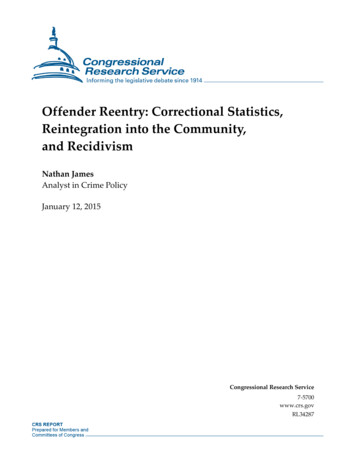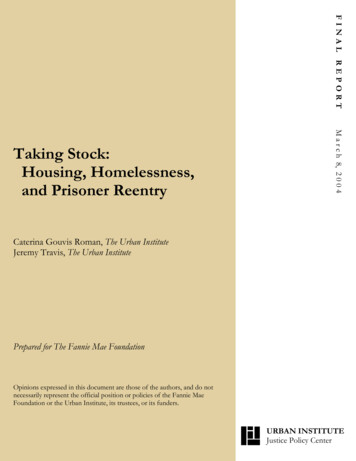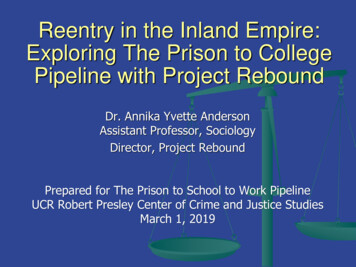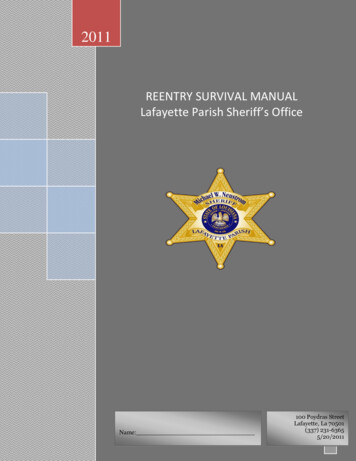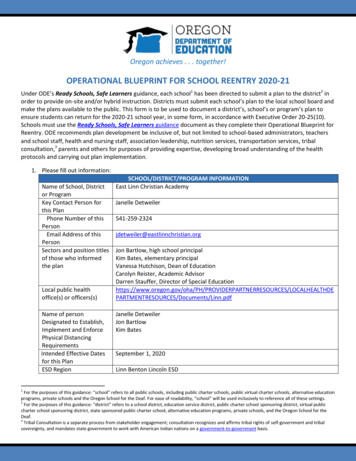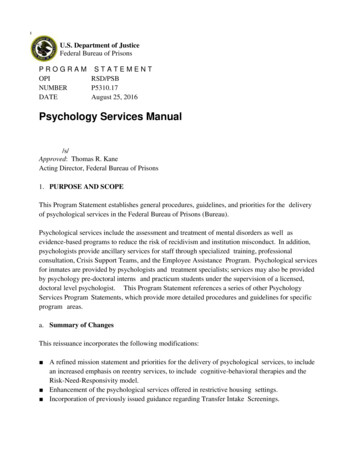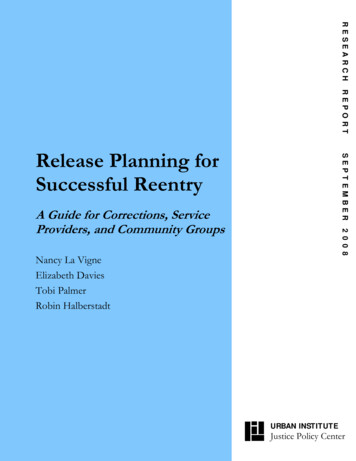
Transcription
RESEARCHDRAFT: Not for circulation or DistributionREPORTSEPTEMBERRelease Planning forSuccessful Reentry2008A Guide for Corrections, ServiceProviders, and Community GroupsNancy La VigneElizabeth DaviesTobi PalmerRobin HalberstadtURBAN INSTITUTEJustice Policy Center
URBAN INSTITUTEJustice Policy Center2100 M Street NWWashington, DC 20037www.urban.org September 2008. The Urban Institute. All rights reserved.The Urban Institute is a nonprofit, nonpartisan policy research and educational organization thatexamines the social, economic, and governance problems facing the nation. The views expressed arethose of the authors and should not be attributed to the Urban Institute, its trustees, or its funders.This research was funded by the Annie E. Casey Foundation. Grant Number 201.2365ii
CONTENTSAcknowledgments . ivExecutive Summary . 2Introduction . 4What Is Release Planning? . 5How Does Release Planning Fit into the Broader Process of Reentry Planning?. 5Who Is Responsible for Release Planning?. 5How and When Does Release Planning Occur? . 6What Are the Key Components of a Release Plan? . 7Basic Needs . 8Transportation. 8Clothing and Food . 10Financial Resources . 11Identification and Important Documents . 12Housing . 13Employment and Education . 15Health Care . 17Physical Illness . 17Mental Illness . 19Substance Abuse/Addiction. 20Support Systems . 21What Are the Opportunities and Challenges of Release Planning?. 24Engaging the Released Prisoner. 24Supervised Releasees. 25Those Released Directly from Maximum Security. 26Unsupervised Releasees. 27Sex Offenders . 29Women. 30Gaining Cooperation from Corrections Staff . 31Collaborating with Community and Agency Partners. 31Funding. 36Revising Policies and Laws. 37Legislative Changes at the Federal Level . 37Legislative Changes at the State Level . 38Ensuring Quality and Accountability. 40Conclusion. 42References. 44Appendices. iAppendix A: Case Studies. iObtaining Financial Resources: Oregon’s Department of Corrections. iiAddressing Identification Needs: The H.I.R.E. Network.iiiAddressing Housing Needs: Idaho’s Transition and Treatment Funding Program . vAddressing Health Care Needs: Massachusetts’ DOC / Mass Health Pilot Program . viManaging Special Populations: Allegheny County State Forensic Support Services .viiCollaborating with Community Agencies: Tennessee’s Good Samaritan Network. ixAppendix B: 2007 UI Discharge Planning Survey. xAppendix C: Scan of Practice.xviiiii
AcknowledgmentsWe would like to thank the Annie E. Casey Foundation for its guidance and support in this project and thefollowing participants from the AECF/UI 2007 and 2008 Discharge for Successful Reentry ConsultativeSessions.Richard ChoProgram OfficerCorporation for Supportive HousingRachel McLeanPolicy Analyst, Criminal Justice ProgramsCouncil of State GovernmentsLe’Ann DuranManager, Office of Offender ReentryMichigan Department of CorrectionsLinda MillsConsultant and Attorney at LawJoan GilleceProgram ManagerNational Association of StateMental Health Program Directors (NASMHPD)Tomi HiersDirector of Programs and ServicesOffice of the SecretaryDepartment of Public Safety and CorrectionalServicesBlaire JonesPolicy AnalystNational Governors AssociationMary Kay KollatReentry DirectorWisconsin Department of CorrectionsAngela LeeReentry AdministratorOhio Department of CorrectionsRodney MitchellDirector, Office of Ex-Offender AffairsOffice of the Mayor of the District of ColumbiaMarta NelsonDirectorLearning InstituteCenter for Employment OpportunitiesRoberta RichmanAssistant Director of Rehabilitative ServicesRhode Island Department of CorrectionsCarol ShapiroFounder and Executive DirectorFamily JusticeA.T. WallDirectorRhode Island Department of CorrectionJamie YoonResearch AssociateCouncil of State Governments Justice CenterStefan LoBuglioChief, Pre-Release and Reentry ServicesMontgomery County Department of Correctionand RehabilitationWe also thank the 43 state correctional agencies that participated in the survey featured in this study:Alabama Department of CorrectionsArizona Department of CorrectionsArkansas Deptartment. of CorrectionCalifornia Department of Corrections &RehabilitationColorado Department of CorrectionsConnecticut Department of CorrectionDelaware Department of CorrectionFlorida Department of CorrectionsIndiana Department of CorrectionIowa Department of CorrectionsKansas Department of CorrectionsKentucky Department of CorrectionsLouisiana Department of Public Safety &CorrectionsMaine - Charleston Correctional FacilityMaryland Division of CorrectionMassachusetts Department of CorrectionMichigan Department of CorrectionsMinnesota Department of Correctionsiv
Mississippi Department of CorrectionsMissouri Department of CorrectionsMontana Department of CorrectionsNebraska Department of CorrectionsNew Hampshire Department of CorrectionsNew Jesrey Department of CorrectionsNew Mexico Department of CorrectionsNew York State Department of CorrectionsNorth Carolina Department of CorrectionNorth Dakota Department of Corrections &Rehabilitation-Adult ServicesOhio Department of Rehabilitation & CorrectionOklahoma Department of CorrectionsOregon Department of CorrectionsPennsylvania Bureau of Inmate ServicesRhode Island Department of CorrectionSouth Carolina Department of CorrectionsSouth Dakota Department of CorrectionsTennessee Department of CorrectionTexas Department of Criminal JusticeUtah Department of CorrectionsVermont Department of CorrectionsVirginia Department of CorrectionsWashington Department of CorrectionsWisconsin Department of CorrectionsWyoming Department of Correctionsv
Executive SummaryThe task of preparing prisoners for the challenges they will face outside the prison walls is a difficult one,made no less so by the pressure many correctional administrators feel to ”do more with less” due toincreasing populations coupled with dwindling budgets. While a comprehensive, holistic approach toreentry planning—addressing the needs of incarcerated persons from the moment of admission throughthe months following release—is clearly the “gold standard” toward which the field is progressing, acritical step in this process that has until now received relatively little attention deals with the preparationof an inmate for the hours and days immediately following his or her release from prison. Without accessto food, clothing, shelter, transportation, personal identification, and other key necessities, former inmatesmay see no other option than to return to illegal activities in order to meet their needs. Thus, correctionsagencies must prepare exiting prisoners for this period and work hand-in-hand with community serviceproviders and agencies to ensure that prisoners receive needed resources and guidance after release.These efforts may make the difference between recidivism and successful transition to the community,This report aims to assist corrections agencies and their community partners in developing andimproving their release planning procedures, but can also be used by jail administrators and staff. Eightfundamental needs confronting exiting prisoners, as well as the administrative challenges andopportunities facing corrections agencies in meeting these needs, are identified through a national surveyof state correctional departments, a complementary scan of practice, and a literature review on the topicof release planning.Needs and Recommendations:Transportation—Provide releasees with transportation from the correctional facility to their releasedestination and evaluate whether the releasee will have access to transportation to services, workand other locations mandated in their release plan.Clothing, Food and Amenities—Provide releasees with clean, appropriate clothing and informationregarding access to food resources.Financial Resources—Provide releasees with enough money to subsidize food, transportation andshelter during the initial days following release.Documentation—Provide individuals with a state-issued identification card.Housing—Identify safe, affordable places where releasees can stay in the days following release andverify that bed space is available.Employment and Education—Ensure that appropriate assessments and referrals have been madeto facilitate the process of finding and keeping a job.Health Care—Conduct an assessment of a prisoner’s mental and physical healthcare status andneeds prior to release and provide the releasee with contact information of a health care2
facility/provider in the community they plan to reside in to ensure continuity of care. For individualswith substance abuse or mental health issues, schedule an appointment with a counselor in thecommunity prior to release.Support Systems—Provide prisoners with a release handbook listing community resources andcontact family members (when appropriate) to notify them of the release date and release plan. Forprisoners without family members, community or faith-based organizations should be contacted toprovide support at the time of release and in the days immediately following their return to thecommunity.It is our hope that corrections agencies will use these recommendations to evaluate their own releasepolicies, make improvements to their procedures, and identify the next steps they can take to ease thetransition from prison to law-abiding lives on the outside.3
IntroductionOver the past five years, significant progress has been made in addressing the issues surroundingprisoner reentry. State departments of correction (DOCs) have launched a variety of initiatives designedto improve the reentry process, but little attention has been paid to the role of release planning aspreparation for the moment of release and as a mechanism for connecting former prisoners withappropriate services and support systems in their communities. The moment of release represents acritical point in time that can make or break an inmate’s successful reintegration into society. Whilevirtually every DOC in the country is engaged in something that could be termed “discharge” or “release”planning, the depth and breadth of such plans vary widely.The purpose of this report is to describe the specific elements that together embody thoughtful andeffective prisoner release procedures, including considerations such as photo identification,transportation, gate money, public assistance access, prescription drug needs, health referrals, housingarrangements, and substance abuse treatment. This information is developed from a national survey ofstate correctional departments, 1 a scan of practice on the topic of release planning, as well as a literaturereview on the topic. The report is intended as a resource for corrections agencies and their communitypartners as they work to improve the way prisoners are prepared for release, as well as a mechanism forraising awareness of the use of both community and governmental resources when planning for release.While the primary audience for this report is staff of state correctional institutions and their communitysupervision partners, many of the recommendations can be applied to jail settings – particularly those thathouse inmates sentenced to a year or more.The report begins by defining what constitutes release planning, situating it within the broader andmore long term process of reentry planning. Drawing from published studies and reports, we identify thevarious components of exemplary release policies and discuss why they are critical to a smooth andeffective discharge procedure. In order to provide a real-world context for these findings, we comparethem to the results of an Urban Institute survey of 43 state departments of correction on their currentrelease policies and procedures. At the end of each topical area, text boxes highlight recommendationsfor what correctional agencies should be doing at the bare minimum to prepare exiting prisoners forrelease; our hope is that readers will not only aspire to implement these base practices, but will also usethis guide to expand their release planning efforts. As most of these practices cannot be accomplishedexclusively by correctional agencies, the next section describes how DOCs can engage both internal andexternal partners in support of effective release planning, including gaining institutional compliance withrelease procedures, encouraging releasees to follow through on their release plans, engaging communityand other agency partners, and influencing revisions to statutory and regulatory barriers to effectiverelease planning. We close with a discussion of the future of effective release procedures and a summary1Respondents were asked to identify whether or not their agency performs a variety of release planning tasks, butthey were not asked to identify whether they perform these tasks for their entire prison population or only a subset ofprisoners. Consequently, DOCs that report performing certain tasks (such as assessments or the provision of housingassistance) may only provide these services to a small share of inmates and the survey results may thereforeoverestimate the extent to which release planning procedures are being implemented.4
of this report’s key recommendations. Appendices highlight case studies of promising release planningstrategies, responses from the UI Release Planning Survey, and a scan of release policies across thecountry.Because all correctional agencies undergo some process or series of procedures associated withthe release of persons from their institutions, this report aims to capitalize on that fact by pushingagencies to think more creatively about how to enhance the discharge process to ensure that the mostbasic needs for successful reentry are met.What Is Release Planning?How Does Release Planning Fit into the Broader Process of Reentry Planning?Ideally, reentry planning begins at the time of intake/admission and extends beyond the time of release toprepare prisoners for long-term post-release success. Release planning represents a distinct componentof the broader process of reentry planning, focusing on success at the moment of release and in the daysand weeks that follow. Ideally, preparing for the moment of release will represent a natural phase in theprogression from intake to reentry (Council of State Governments 2005; North Carolina Department ofCorrections 2007). For example, while the larger reentry plan may address long-term employment needsby providing in-prison training and education, the release plan would focus on the more short-term needfor transitional employment. Release planning often draws upon the assessments, resources andrelationships developed during the course of a person's incarceration and in many respects, representsthe bare minimum preparation that a DOC should engage in prior to a prisoner's release. For example,while New Jersey’s reentry efforts (referred to as a transitional model made up of four phases) begin atintake, at six months prior to release prisoners engage in a series of workshops designed to prepare themfor discharge. Several DOCs have implemented the National Institute of Correction’s Transition fromPrison to the Community (TPC) model to better prepare prisoners for returning to the community. Underthe TPC model, reentry also begins at intake (the institutional phase), but discharge planning, or planningfor release, essentially begins after an assessment and classification have been completed and after thebehavior and programming issues have been outlined.Who Is Responsible for Release Planning?The management of prisons and the management of post-release supervision are traditionally seen asdistinct areas of expertise and responsibility, even when located within the same agency (Burke 2008).Chiefly responsible for “the maintenance of safety and security” within their institution, prison officials maynot view themselves as responsible for an inmate’s welfare once that individual is no longer in DOCcustody. Similarly, post-release supervision agencies—probation and parole—often interpret their role asbeginning when an inmate first arrives in a field office after release from prison. This perceived gap inresponsibility during the transition to post-release status represents one of the largest challenges indischarge planning; if the responsibility of the DOC ends at release and the responsibility of probation and5
parole agencies begins during the intake interview, on which agency can an inmate rely at the moment ofrelease? Although state corrections agencies typically assume the task of release planning for theirinmates, the process has the potential to represent a collaborative effort between prison officials andparole officers, along with representatives of community groups and other key stakeholders.How and When Does Release Planning Occur?The timeline for release planning varies across institutions and depends upon several factors, includingthe availability of resources (both to the DOC and within the community), the existing relationshipbetween corrections and social services, and the extent to which the releasing agencies can predict theinmate’s release date. Release planning can occur as little as one week prior to release to six monthsprior to release, in which activities gradually increase until the day of release (Taxman et al. 2002;Gaynes 2005). While adequate time is needed in order to secure resources, to communicate withagencies and persons involved in an inmate’s reentry plan, and to meet with the inmate, correctionsagencies must be mindful that many activities specifically focused on the moment of release cannot beplanned for too far in advance (Council of State Governments 2005). For example, housing can only besecured once an individual’s release date is known; similarly, benefits and resources available toprisoners at the moment or release, or soon after, are contingent upon timely submission of applicationmaterial based upon a known release date.Release activities typically include, at a minimum, an individualized assessment and a writtenrelease plan. In general, corrections agencies should administer an assessment to identify what aninmate will need in order to be released, including any problems that might occur with meeting conditionsof release (Byrne and Taxman 2004). Such assessments are relatively commonplace, with 70 percent ofUI survey respondents indicating that they conduct pre-release risk and needs assessments. All prerelease assessments cover housing and employment needs, with most also identifying medical(substance abuse history and treatment, post-release mental and physical health care, current and futureprescription medications), identification, and income and benefits needs.Assessments often identify inmates who have the greatest need for services and support afterrelease, and these inmates are most likely to receive written discharge plans when they leave prison.Although nearly all corrections agencies provide an individualized written discharge plan to at least someinmates, only two out of five provide such plans to all exiting inmates. Of the DOCs surveyed, 37 percentprovide plans specifically tailored to inmates released to parole supervision or probation, 44 percent toinmates with mental health disorders, 30 percent to inmates with a history of substance abuse, and 28percent to those with co-occurring disorders. Over three-fourths of written discharge plans (79 percent)include contact names, phone numbers, and addresses of referrals and resources. Nearly all DOCs (94percent) also offer a discharge planning or pre-release class to at least some share of inmates. The classtypically starts at least two months before release and is taught by staff from within the institution or fromcommunity-based service providers.6
Figure 1: Top Eight Needs Assessed by DOCsHousing72Employment72Substance Abuse Treatment67Current Medication65Identification Needs63Veteran's Benefits61Mental Health History61Substance Abuse History61% of DOCsThe vast majority (84 percent) of DOCs surveyed indicated that their agency has formal policies inplace to ensure that discharge procedures are followed properly, with 42 percent indicating that theiragency has written institutional and/or employee performance measures related to discharge planningand 67 percent reporting that discharge planners are required to contact referral agencies prior to theinmate’s release to confirm that services and space are available (67 percent).What Are the Key Components of a Release Plan?Every corrections agency has a system in place to guide how a person is released from prison; somesystems are nothing more than checklists while others involve extensive documentation of prisonerhistories and significant outreach to service providers in the community. While these policies andprocedures vary considerably across agencies, a logical succession of release preparation activities canbe identified by anticipating the immediate challenges prisoners encounter along the pathway fromconfinement to freedom. The most immediate of these needs involves the clothes on one’s back, followedclosely by some minimal amount of cash on hand to cover immediate expenses like transportation.Shelter will be necessary on the evening of the day of release, even if that shelter is temporary. To obtainmore permanent housing, former prisoners will need photo identification, leads on employment,vocational classes, or perhaps more remedial education and training such as literacy and life skillsprograms. Those exiting prison with substance addictions and chronic physical and mental healthconditions will also require linkages to treatment, medication, and ongoing health care in the community.Each of these challenges is inextricably linked to the others. Exiting prisoners are unlikely to havefunds to support themselves without a job, yet they cannot obtain employment without a social securitynumber and cannot commute to and from the job without access to transportation. Likewise, obtaininghousing typically requires photo identification, a security deposit, and evidence of ongoing employment.To complicate matters, the exiting prisoner may have health or substance addiction problems that make it7
more difficult to navigate this web of challenges that he or she will likely encounter upon release.Unfortunately, the returning prisoner may forego treatment or medications in order to attend to lowerorder needs, such as food and shelter, and compromise their future stability within the community. And,while many released prisoners are able to rely on family to aid in this release process, others haveburned familial bridges and must resort to whatever surrogate social support resources exist. Thesechallenges are considered below in the context of the release planning process.Basic NeedsWhen a person leaves prison, their most immediate needs will be for transportation, food, and clothing;they must have a means for getting to their release location, civilian clothes to wear on their journeyhome, and food to sustain them as they navigate the first few hours on the outside. They also requiresome minimal amount of cash on hand to fulfill these immediate needs. Personal identification is critical inthis initial period as well, as it is a prerequisite for achieving the more long-term reentry goals of finding ajob and securing housing. Unfortunately, these basic necessities represent some of the most overlookedneeds of any returning prisoner (Gaynes 2005).TransportationAt the moment of release, transportation represents a basic critical need for exiting prisoners. For thosewithout family members to meet them at the prison gates or DOC drop off point, public transportation istheir likely source of conveyance. Yet access to public transportation can be restricted both by thelocation of bus stops (which may not be within walking distance) and the hours of operation. For example,prisoners who are released or dropped off after hours may have difficulty accessing public transportation2and have no choice but to wait until services resume. This situation can make individuals vulnerable tovictimization and may also create opportunities for criminal behavior.In the days immediately following release, former prisoners will also need reliable transportation inorder to follow up on referrals from their release plans, as well as to meet initial parole requirements (ifapplicable). However, transportation challenges represent a significant barrier for prisoners attempting toaccess services, with nearly one in four released prisoners reporting difficulty accessing publictransportation (La Vigne and Wolf 2004; Rossman and Roman 2003). These difficulties could result froman overall lack of public transportation in the area, from difficulties former prisoners encounter whennavigating transportation systems, as well as from barriers to driving one’s own vehicle, such aschallenges in getting a driver’s license reinstated due to past suspensions or revocations (see Pawasarat2007). Particularly for former prisoners who have relocated to an area that has limited publictransportation options (such as a rural community), following up on release plan referrals to resourcesand service providers will be difficult. Even former prisoners who have relocated to an area with ample2. About one in ten prisoners returning home in Maryland were released during non-daylight hours (Visher, La Vigne, and Travis2004); further, some
facility/provider in the community they plan to reside in to ensure continuity of care. For individuals with substance abuse or mental health issues, schedule an appointment with a counselor in the community prior to release. Support Systems—Provide prisoner
